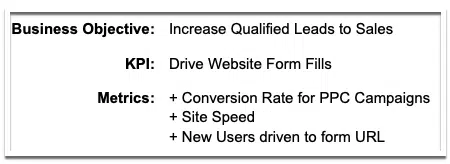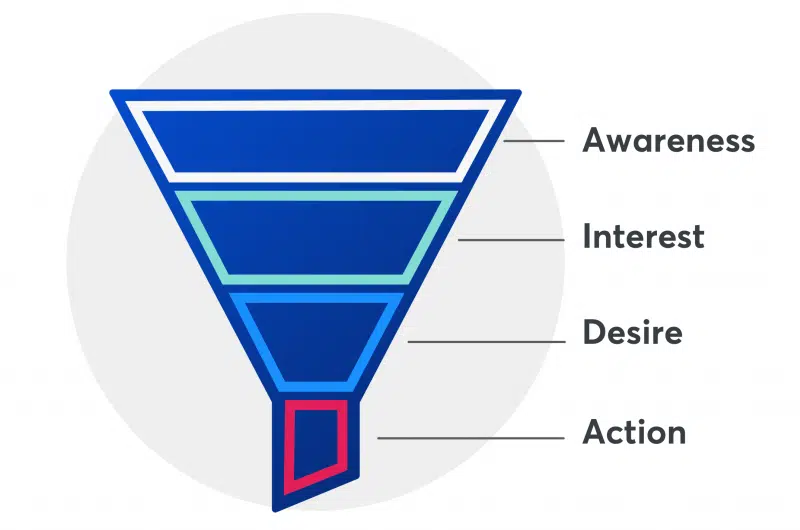When working with a new PPC client, I help them establish goals aligned with their business objectives. Surprisingly, many lack clearly defined campaign goals beyond boosting traffic or conversions.
Let’s explore a framework for setting effective key performance indicators (KPIs) and metrics aligned to your business goals for each funnel stage.
PPC KPIs and metrics: How do they differ?
It’s essential to identify goals and KPIs to evaluate success.
- KPIs are your end goals.
- While metrics are data points that measure progress toward those goals.
For example, if your goal is to increase qualified leads, metrics would include conversion rate, new users driven to a specific URL, etc.

PPC campaigns can help achieve many objectives, so understanding the difference between KPIs and metrics is key to setting yourself up for success. You need to pick KPIs that matter for your business and tie them to relevant metrics.
Clients commonly apply uniform goals to all campaigns regardless of their place in the marketing funnel. However, you should tailor goals and metrics based on the funnel stage to measure performance accurately.
Why aligning PPC goals with the marketing funnel matters
While paid search benefits bottom-of-funnel marketing, exclusively relying on it is a mistake.
PPC campaigns can aid each part of the marketing funnel, provided you set them up accordingly and measure them against metrics and benchmarks that make sense for that stage.
Clients often make the error of setting identical goals for campaigns at various funnel stages. This overlooks the need to align campaigns with specific goals, requiring distinct KPIs and metrics for fair and accurate evaluation.

Dig deeper: How to use always-on marketing in paid search
Top-of-funnel PPC campaigns
Top-of-funnel campaigns should be designed to create awareness where there isn’t. You want these campaigns to capture a broad audience of potential and future customers and (hopefully) generate some interest in your product or service.
With reach as a high priority, these types of efforts often use campaign types that provide high visibility for a lower cost.
Because PPC can be (incorrectly) synonymous with bottom-funnel marketing, it’s important to differentiate top-of-funnel campaigns from the rest of your PPC marketing.
Top-of-funnel campaigns often utilize the Google Display Network, which has different benchmarks, ad content, and benefits.
Ensure you’re evaluating your top-of-funnel campaigns fairly using appropriate KPIs and metrics.
KPIs for top-of-funnel PPC campaigns
- Increase brand awareness.
- Increase website traffic.
- Drive social media engagement.
- Boost brand engagement.
Metrics for top-of-funnel PPC campaigns
- Impressions
- Cost per mille (CPM)
- Click-through rate (CTR)
- Engagements (Google Ads)
Dig deeper: Guide to PPC top-of-funnel reporting
Get the daily newsletter search marketers rely on.
Mid-funnel PPC campaigns
Mid-funnel campaigns can be tricky because they can encompass a variety of goals and campaign strategies. They can include:
What differentiates these campaigns is that they’re designed to meet users in the Interest/Consideration phase. That means your KPIs and metrics should be tailored to that end goal, finding users interested in your product or service and helping them consider whether they should take action.
KPIs for mid-funnel PPC campaigns
- Establish authority in the industry.
- Increase engagement.
- Drive consideration.
- Nurture leads.
Metrics for mid-funnel PPC campaigns
Bottom-of-funnel PPC campaigns
Finally, we get to what many folks think of when they speak about PPC campaigns – bottom-of-funnel efforts that are extremely effective in driving actions like form fills, phone calls, purchases and requests for a quote.
These include:
- Search campaigns with extremely high-intent keywords.
- Display remarketing campaigns targeting users who engaged with mid-funnel efforts to move them down the funnel.
KPIs for bottom-of-funnel PPC campaigns
- Acquire new customers.
- Increase revenue.
- Generate leads.
- Increase purchases.
Metrics for bottom-of-funnel PPC campaigns
- Primary conversions (i.e., form submissions or purchases)
- Conversion rate
- Cost per acquisition/conversion (CPA)
- Return on ad spend (ROAS)
- Average order value (AOV)
- Cart abandonment rate
- Item quantity
Paid search attribution in GA4
Marketing attribution can change how you evaluate the performance of your PPC campaigns.
By default, your PPC campaigns on Google and Microsoft Ads use a last-click attribution model unless you manually switch to data-driven attribution.
In July 2023, Google announced they would retire first click, linear, time decay, and position-based attribution ******.
GA4, on the other hand, uses the cross-channel data-driven model as their default attribution model. It also provides paid and organic last-click, and Google paid channels last-click ****** that you can apply to certain reports at the property level.
Dig deeper: How to combine GA4 and Google Ads for powerful paid search results
The intersection of metrics and KPIs with business goals
Sometimes, your broader business objectives clearly tie into specific KPIs and metrics. Other times, you may have to get creative with aligning PPC efforts with the larger business goals.
The worst mistake you can make is to set KPIs and metrics that don’t contribute to business success. The second worst is failing to clearly and simply explain how KPIs and metrics contribute to business success.
You often try to get buy-in and budget from key stakeholders who need you to help them connect the dots. Help them see the value by clearly stating how your KPIs support the company’s aim and mission.
Setting KPIs and metrics for PPC
Ultimately, the KPIs you set for your PPC efforts should tie directly to your business objectives, and the metrics you use to measure those KPIs will depend on the nature of your business and the set-up of your campaigns.
Do your future self a favor, and don’t make the mistake of setting blanket KPIs for all your efforts. You’ll fare better (and your boss or client will be even more impressed) if you tailor your KPIs to the marketing funnel stage your campaigns are built around.
Opinions expressed in this article are those of the guest author and not necessarily Search Engine Land. Staff authors are listed here.
Source link : Searchengineland.com
